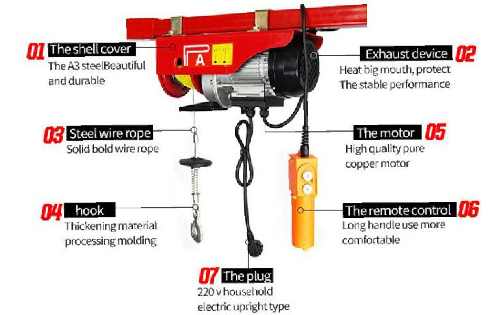


Lever Block Hoist A Essential Tool for Lifting and Moving Heavy Loads
In various industries, the need for efficient lifting and moving of heavy loads is a common challenge. Among the multitude of lifting devices available, the lever block hoist stands out as an essential tool that combines simplicity, efficiency, and versatility. This article explores what a lever block hoist is, how it works, its applications, and key considerations for safe usage.
Understanding Lever Block Hoists
A lever block hoist, also known as a lever hoist or chain hoist, is a manually operated lifting device that uses a lever mechanism to lift and lower heavy loads. It consists of a hook, a chain, a lever arm, and a ratchet mechanism. The lever arm, when pulled down, engages the ratchet, allowing the chain to move in a way that raises the load attached to the hook. The hoist can also control the descent of the load by gradually releasing the lever.
These hoists are designed for a wide range of lifting capacities, typically ranging from half a ton to several tons, making them suitable for various applications in construction, manufacturing, and even for personal projects.
How It Works
The operation of a lever block hoist is straightforward. First, the user secures the hook to the load they intend to lift. As the user pulls down on the lever, the ratchet mechanism engages, allowing the chain to move and lift the load upward. By releasing the tension on the lever, the load can be lowered in a controlled manner. The mechanical advantage provided by the lever arm allows users to lift much heavier weights than they could by using sheer muscle power.
Applications
Lever block hoists are incredibly versatile and find applications in many sectors
1. Construction Sites These hoists are commonly used to lift heavy materials such as beams, scaffolding, and machinery. They are particularly useful in areas where electric hoists cannot operate due to the lack of power sources.
3. Warehousing Heavy lifting in warehouses is simplified with lever block hoists, whether for loading and unloading goods or organizing inventory.

4. Automotive Mechanics frequently use lever hoists to lift engines and other heavy parts during repairs and maintenance.
5. Home and DIY Projects For homeowners and DIY enthusiasts, lever block hoists can help with various projects, from lifting heavy furniture to assisting with large construction tasks.
Safety Considerations
While lever block hoists are valuable tools, proper safety precautions are essential when using them. Here are some key safety tips
1. Weight Capacity Always ensure that the hoist is rated for the weight of the load being lifted. Exceeding the capacity can lead to equipment failure or accidents.
2. Inspection Regularly inspect the hoist for any signs of wear or damage. The chain should be free of kinks, and the hooks should be intact and functional.
3. Proper Use Familiarize yourself with the hoist's operation instructions. Ensure that the load is securely attached before lifting and maintain a clear area around the lifting operation.
4. Use Personal Protective Equipment (PPE) When operating a lever block hoist, wear appropriate PPE, such as hard hats and steel-toed boots, to protect against potential hazards.
5. Training Ensure that anyone using the hoist is adequately trained in its operation and understands the safety protocols.
Conclusion
The lever block hoist is a remarkable invention that continues to serve as a reliable lifting solution across various industries. Its simplicity, efficiency, and adaptability make it an indispensable tool for professionals and DIY enthusiasts alike. By understanding its operation, applications, and safety precautions, users can harness the full potential of lever block hoists while ensuring a safe working environment. Whether you are lifting heavy machinery on a construction site or managing inventory in a warehouse, this robust device is designed to make your lifting tasks easier and more efficient.



